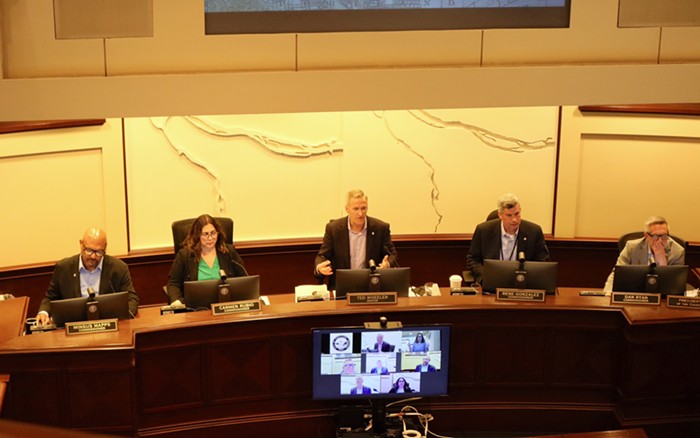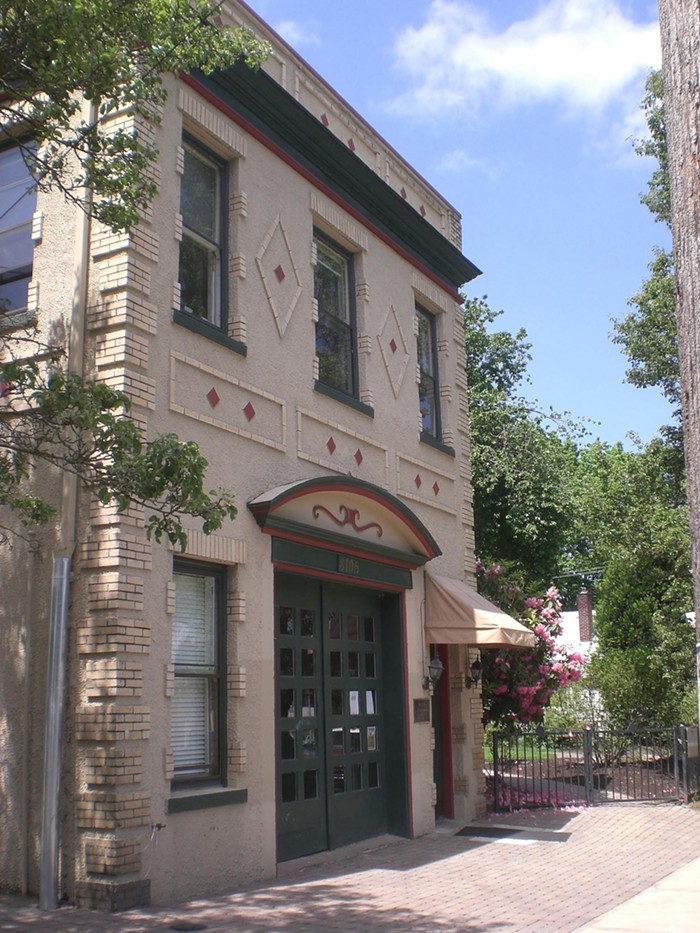BILLBOARDS ON HIGHWAYS are rarely subtle. That's not their job. But the ones that went up on Interstate 205 during the most recent primary election, near a semi-suburban pocket around Gladstone, were more obvious than most.
One on side: Mount Hood presiding over a postcard-worthy vista. On the other: darkness, smog, and cars. The message? PROTECT CLACKAMAS COUNTY... FROM PORTLAND CREEP. It was a blunt appeal for a slate of Clackamas County commissioner candidates—paid for by the Oregon Transformation Project Political Action Committee, a Lake Oswego PAC with deep ties to the state Republican Party.
In a county that resoundingly voted no on Sellwood Bridge fixes and against unchecked urban renewal, the sentiment seemed to resonate. Two of the candidates on that slate made it to runoff races this November. And those same operatives are now backing a measure this September aimed at TriMet's light-rail line to Milwaukie.
The game has changed for the Tea Party-inflected movement that erupted over these issues nearly two years ago—for those inclined to defend Clackamas' peculiar rural/suburban blend. Whether anyone wanted it or not, there was a declaration of war, against an all-too-familiar villain.
Portland—and its bikes and trains and crime and apartment bunkers. And it wants your land. And your jobs.
WHY THEY HATE US
But is that true? Is that really how Clackamas voters see Portland? Or is that just what moneyed political operatives—looking for a right-wing beachhead just outside liberal Multnomah County—want people to think? The answer, to all, is yes.
"If you were to put the question to a vote in Clackamas County, 'Do you dislike Portland?'—it would probably get a majority," says State Representative Dave Hunt, a Democrat who took the brunt of the right-wing whacks and finished fourth in the Clackamas County chair race this May. "But when you look at it in the context of having an integrated economy and transportation and health care systems, people pretty quickly realize we are a region and drawing a mythical wall at the border doesn't make any sense."
All the same, he allowed, "It's an interesting tactic."
"I hate to totally define Portland creep," says Bridget Barton, speaking from the Lake Oswego offices of Third Century Solutions, the consulting outfit that's running the Oregon Transformation Project PAC.
And while the PAC's "creep" billboards near Gladstone were pretty specific—mentioning physical ills like "congestion," "density," and "crime"—Barton goes elsewhere. Light rail. Spending priorities. Density requirements.
"Voters are concerned about the amount of spending on some of these big-ticket projects," she says. "That's a big piece of it when we talk about 'Portland creep.' They seem to be what a lot of voters feel are pet projects of city and regional governments and not really what voters want."
But the question, for critics of the PAC and its spending, is who's doing the talking now—down-home Clackamas voters, or political insiders like Third Century Solutions, based in tony Lake Oswego.
Another of Third Century's principals is Rob Kremer, treasurer for the Oregon Republican Party, which also happens to be based in Lake Oswego. And the consulting company lists one other prominent Republican as an "associate": state party boss Allen Alley. (Barton says there's no "shared strategy" between the state party and the PAC.)
The PAC's chief aim is to support "authentic" and business-friendly candidates and issues. But by placing its finger on the scale in local races, the PAC joins the county's local Tea Party chapter, Americans for Prosperity, and other familiar names like Loren Parks and Kevin Mannix.
"What you're seeing is a lot of people who have a history of funding statewide races shifting their political strategy because they keep losing," says Scott Moore, communications director for liberal advocacy group Our Oregon.
Clackamas' ongoing economic troubles have made the place "ground zero," he says.
"And one of the easiest ways to get people organized is to give people a villain," he says. "One of the biggest villains is Portland, or whatever they think Portland represents to them."
According to state records, the PAC gave just one of the three candidates on its slate, former Wilsonville Mayor John Ludlow, more than $115,000 in 2012—the biggest chunk of the $160,000 Ludlow raised this calendar year.
That cash helped put Ludlow in the runoff for county chair, against Democrat and current County Commissioner Charlotte Lehan—and, as the Oregonian reported this spring, even helped persuade Ludlow to run in the first place. Ludlow, of course, is no fan of "Portland creep."
The PAC also helped get another candidate on its slate, former State Representative Tootie Smith, into a runoff against incumbent Commissioner Jamie Damon. Previously, it's weighed in on races in Estacada and Damascus. And it's contributed to September's light-rail initiative—a measure that would put the county's already-promised $25 million contribution up for a public vote.
Barton insists the PAC is only surfing a "rising tide" of discontent and that most of the votes before the primary, on Sellwood and urban renewal, were lopsided affairs.
"This is a fascinating and unprecedented movement, and it isn't us. It's the people," Barton says. "They started before anyone knew who we even were, and they were halfway home before we even got involved. We truly are just helping a movement."
"IT'S JUST WHERE BAD THINGS HAPPEN"
I'm heading down SE 82nd to the all-night Walmart in Happy Valley—against my better judgment—waiting to see what the billboard promised. Any minute now I'll cross from a dense, chaotic, elitist swamp into a wide-open, quiet, and homespun oasis.
Except that doesn't happen. There's no demilitarized zone, no demarcation line, nothing much, really, to mark the change. There's a small sign—and the same miserable parade of speeding cars, fast-food joints, and big box monsters that dominate both sides of the border.
It's not like this everywhere. Clackamas County is big and diverse. It's got Mount Hood, as well as forests and farms and river towns and suburban tract homes. But here? On the sprawling, car-choked border? Portland has long creeped in.
Not that everyone totally minds.
Julia, leaving Walmart with a pack of cigarettes, says she moved from SE 181st and Stark six months ago, mostly to get away from crime and noise. "It's more peaceful. To me."
But, for instance, she doesn't share some of her neighbors' disdain for light rail. "It's a blessing," she says. "Besides, gas is atrocious."
Then there were the Marets, Chris and Kristi, who'd trekked in some 25 miles from "up on the mountain" in Estacada. Portland's not a bad place, "It's just where bad things happen," says Kristi, before adding, "I don't mind visiting, though."
They like OMSI and the Oregon Zoo, but the message on the billboard hit home for them.
"I don't want it creeping my way," Chris says. "I like my space."
Demographics might be helping the "Portland creep" message sink in. As Portland and Multnomah County gentrify, nonwhite residents are increasingly moving east and south in search of cheaper homes.
Clackamas, according to Census statistics, is not only wealthier and less dense, on average, than Multnomah County. It's also, amazingly, whiter.
One woman on her way into the Walmart, Lekeisha, said she moved from Portland back in 2009. She wouldn't mind more Portland where she's living.
"It's not going to affect what Clackamas County is," she says. "If anything, it's going to make it more diverse and more available to different kinds of..."—she pauses—"...communities."
SMALL-TOWN CHARACTER
At first, Lake Oswego City Councilor Mary Olson was circumspect about Portland's role in the Clackamas unrest—but then jumped at the chance to slay what she thought was a common misconception.
"It's not that the old hicks out in Clackamas County are afraid of change. Which is how [critics] portray it," she says. "It's more that citizens are feeling like they don't have a voice."
They want to be able to weigh in on some of these decisions like light rail or more density or zoning, or whatever. I'm a good example of that."
Olson, who helped scuttle a streetcar extension to Lake Oswego, is on the front of the next big fight. She's listed as the director of a PAC called Clackamas Rail Vote. The group is raising cash for a September referendum that asks whether voters would like a say on funding for the Milwaukie light-rail line. If voters say yes, a second vote would be held, this time on whether to actually cancel the county's contribution.
Like other measures, it's been getting vocal support from the local Tea Party chapter and big checks from establishment right-wing funders like the Oregon Transformation Project PAC and Loren Parks.
But Olson rejected the idea that her measure, or any others, need that help. She says it's about regular people from both political parties being fed up over how their tax dollars are spent.
"That's why these initiatives are passing by 70 percent. That's why candidates are winning," she says. "The rest of this year is going to be very telling."
Olson also says fears over Portland—and it's prizing of "frou-frou stuff" like rail and bike lanes over streets and potholes—play just a "tiny part" in what's happening. But Olson, who moved from Portland 20 years ago to give her kids better schools and bigger yards, also admits she wants to preserve Lake Oswego's "small-town character."
"We live where we live for certain reasons." But after she retires? "Maybe I'll go back to Portland."
DON'T TREAD ON ME
John Williams Jr., a self-described "liberal," presided over Oregon City as mayor from 1999 to 2003. At 84 years old, he's lived in the county almost his entire adult life. He's watched as an almost entirely rural county more than tripled in population over the past 50 years.
Clackamas County still doesn't know itself, he says, let alone have the wherewithal to think beneficently of neighbors like Portland. He mentioned the Tea Party-fueled Sellwood Bridge rebellion in 2010-2011. Voters rejected a $5 vehicle registration fee that would have raised $22 million for the project.
"Whoever thought it would pass?" he asked. "Why would a guy in Government Camp add five bucks to his [vehicle license fee] to pay for a bridge in Portland... It's hard for them to get the big picture when some of them live almost in Salem. They don't connect with Portland as part of their community."
If anything unifies the county, he says, it's their concerns about density and whether regional planners like Metro ought to be able to impose its will.
"That's generally an attitude of people in Clackamas County," he says, even in more progressive bastions like Oregon City. "They don't want density."
But those common concerns—and the fact that Clackamas is "more conservative than Multnomah County"—is part of what makes the place fertile ground for right-wing messaging about "Portland creep."
Williams says his friends are "reasonable people who don't talk like that." But he also knows firsthand the pervasive role of outside interest groups. When he helped petition for a ballot measure that would send urban renewal plans to voters, his group received a check from Loren Parks.
"I wouldn't have accepted it if I'd known it was coming in," he says—explaining that someone else on the committee had already taken the contribution before he found out about it. "There are some people who just eat that [negative] stuff up. They love it. They want to feed it."
CREEP ON, PORTLAND CREEP
The sinister-sounding phrase "Portland creep" might have started in Clackamas, but it likely won't die there.
Like the Eye of Sauron, conservative groups like the Tea Party, and even the Oregon Transformation Project PAC, have slowly shifted their gaze toward another Portland neighbor: Washington County.
Barton, of the Oregon Transformation Project PAC, confirms her group has diverted "a very scant" amount of cash to anti-rail activists there. But she also says those agitating in the corporate-dominated county have a sturdier base of support than in Clackamas.
"These people are already doing their thing on their own," she says. "We see that, and we'd like to help. But they're so well organized and on their own, they really don't need us very much."
Maybe. But this could also be the beginning of a grassroots plan to paint Portland's neighbors a deeper shade of crimson. One thing is certain:
"They've consolidated their campaign in Clackamas," says Our Oregon's Moore. "And they're exporting that model to other places."



















